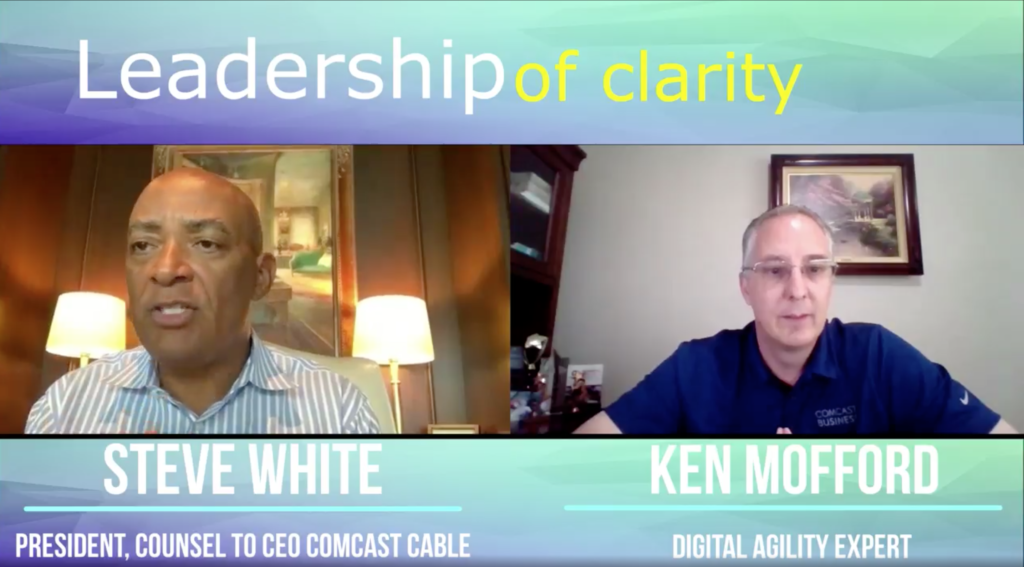As the social and economic climates surrounding our work environments continue to fluctuate, you might be wondering if your leadership style is still relevant. Some people believe that different situations call for different approaches, while others lean into consistent methods that fit their personal values and strengths. I recently participated in a podcast where I had the chance to talk about an approach that has served me well over the years: leadership of clarity.
Whether you’re running a nonprofit, a start-up company, or billion-dollar business initiative, we’re all looking for the same thing: a specific outcome. And that specificity requires clarity from the start. In business, I’m sure most executives agree their specific goal is centered on growth.
When Bain & Company asked two thousand companies what they expected to accomplish in the next ten-year period, most said they expected to grow at least 5.5 percent or better every year. Yet only one in ten actually achieved that modest goal. In short, consistent growth is tough!
So how do we as leaders consistently motivate others, mentor staff, and deliver on the promises we’ve made to our stakeholders? Remember that it’s not always about the talent on the team: it’s often more about who is most aligned around the vision and their ability to execute it with success. Making clarity the centerpiece of my leadership style has stood by me in both triumphant and turbulent times. Here’s what I focus on when I’m aiming for alignment:
Clarity About Goals
I like to think of expectations in terms of where we want to go, which hill we’re trying to climb, and what’s the specific altitude of that summit. Metrics are a huge help in this sphere. Without established metrics that you’ve agreed to follow and discuss on a regular basis, your team will be left to decide what benchmarks define success. If you decide on what information is helpful from the outset, everyone is better equipped to recognize where they’re falling short, and how they can address the shortfalls.
Clear About Expectations
Remember the hill? This tenet relates to the how we’ll reach the top. Setting expectations can include exhibiting the behaviors and values you want the team to model. The “how” in my book is what strategies you’ll apply and what productive behaviors you’ll use.
BetterWorks Chief People Officer Diane Strohfus says, “Everyone needs to have clarity of what’s most important to focus on, both on the work they perform, and on the values and behaviors that are most valued as an organization. When everyone understands what needs to be accomplished, and what behaviors are accepted, it is much easier for them to succeed!”
Clear Feedback and Plans for Development
As the team leader, you need to keep these questions on the forefront of your mind: How can I help someone who’s faltering? What questions need to be explored about this falling metric? You’ve heard the phrase “There’s no ‘I’ in TEAM.” This is where you need to put that philosophy to work. Talk specifically about the adjustments you need to meet expectations and then discuss the metrics you’ll watch together. Your team and your organization will be grateful you’ve offered feedback and discussed how to pivot—particularly when you reach the summit together.
When is clarity most helpful? All the time, but my experience has been that it’s especially mission critical when the number of people you’re leading becomes significantly larger. For instance, the Carlisle Companies is home to more than thirteen thousand employees worldwide. President and CEO Christian Koch prioritized clarity best when he said, “Like the old game of telephone, we lose a fraction of our message each time a message is repeated, and by the time it reaches a few people down the line, it is fundamentally altered. Just from the CEO to a manager level—without clarity—the message can be lost.”
Whether you’re leading a team of two or two thousand, I’m confident you’ll find my focus on clarity will serve you well. Don’t leave goals, expectations, and feedback up to chance. Why not give you and your team some certainty with direct, consistent, and specific communication? With so many unknowns on the horizon—including how much your message can be diluted within your own company—you’ll be glad you’ve taken unnecessary guesswork out of the equation.






Hi Steve,
This message is inspirational. Thanks for sharing. I am currently in transition but have been in the workforce for over 20 years. Last 18 years, I worked for Comcast. I have worked with many leaders. Whether it was a good or bad experience, I have learned something from each of them. Speaking with clarity is a fundamental skill of a great leader. I think transparency also plays a key role and must be intentional. Without transparency, employees walk away with doubt and anxiety. Transparency is not about telling the employees everything. It’s about speaking with honesty all the time.
-Lydia Tran